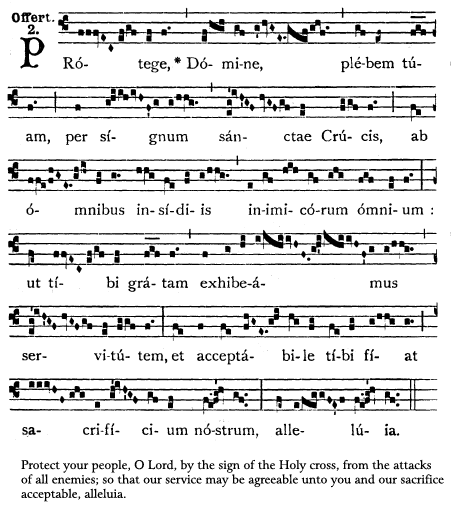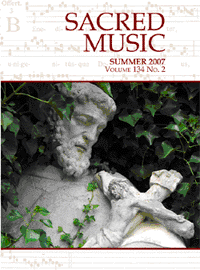We are very grateful that Bishop Joseph Perry, Aux. Bishop of Chicago, will celebrate the 4pm Mass for our group on Thurs, Oct 18th at 4pm at during the priest-training seminar Missa in Cantu.
Category Archives: News
Protege, Domine, plebem tuam…
- Thursday, 13 September 2007 14:02
- SacredMusic
- 0 Comments
Here is the Offertory for tomorrow’s Mass, the Triumph of the Cross, in both the ordinary and extraordinary form of the Roman Rite. Commentary by Dom Johner follows:

Johner writes:
The sentiment of the Offertory is similar to that of the Communion, but places greater stress upon the protection from the enemies of the soul. These enemies must not hinder us from the service of God, must not disturb our interior peace, must not rob us of the joy in God’s service, must not delude us with the enticements and seeming joys of the world, must not induce us to desert our recognized duty and become unfaithful. Against all these dangers may the holy cross protect us and strengthen us in perseverance and fidelity in the service of God.
If in this manner our service becomes pleasing to the Lord, then our worship and the union of our sacrifice with the Eucharistic Sacrifice will also become pleasing to Him.
Something akin to melancholy pervades the melody. It has a very modest development. Despite its length, its greatest interval is a third.
The first and second phrases begin with the same descending motive. Abstracting from this, the first half of the first phrase confines itself to the range of a fourth, the second half to a fifth, as does also the third phrase. The second phrase alone has a range of a sixth. Over exhibeamus servitutem the melody of per signum sanctae Crucis is extended and developed, while that of sacrificium is simplified. Only the first syllable of this word receives any special accent. Omnibus insidiis resembles acceptabile fiat. An enlivening effect is produced by the pressus, particularly over signum Crucis and the corresponding passages.
The whole should be rendered as a fervent prayer, without strong accents. It should breathe the conviction of a soul conscious of its own weakness in the face of the evil one, but firmly reliant on the power of Christ’s cross. In sentiment it is closely allied to the Offertory Domine Jesu Christe of the Mass for the Dead, which likewise belongs to the second mode.
Full Polyphonic Papal Mass
- Wednesday, 12 September 2007 07:37
- SacredMusic
- 0 Comments
Here is a report on the full polyphonic Mass in Vienna:
With the Mass celebrated in the cathedral of Saint Stephen on Sunday, September 9, Benedict XVI revived a musical and liturgical tradition that had been interrupted for many decades.
Within living memory, in fact, the last papal celebration accompanied by the complete performance – Kyrie, Gloria, Credo, Sanctus, Agnus Dei – of a great polyphonic Mass dates all the way back to 1963. That Mass was celebrated in Saint Peter’s, and the composer selected was Giovanni Pierluigi da Palestrina, the dean of Roman polyphony in the sixteenth century.
This time, the Mass was celebrated in Vienna, and the composer was, rightly, Austria’s Franz Joseph Haydn and his stupendous “Mariazeller Messe” of 1782, for chorus, soloists, and orchestra.
Gregorian chant also made an important return appearance in the papal Mass on September 9. During communion, the choir repeatedly sang the antiphon “Vovete,” from the propers for that Sunday in the missal of the ancient rite, in alternation with verses from Psalm 76, also sung in Latin: “Make and keep vows to the Lord your God. May all present bring gifts to this awesome God, who checks the pride of princes, inspires awe among the kings of earth.”
The book that provides full communions and psalms is Communio.
Crux et Cithara
- Tuesday, 11 September 2007 13:06
- SacredMusic
- 0 Comments
Crux et Cithara is a 1983 book edited by Fr. Robert Skeris in honor of the 70th birthday of Johannes Overath. It contains many important pieces that bear on the current debate on Church music. The entire text is now hosted by MusicaSacra.com.
Among the pieces is J. Ratzinger’s “Theological Problems of Church Music”, which is extracted as a separate file.
